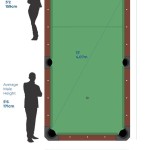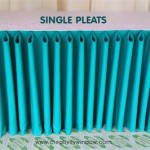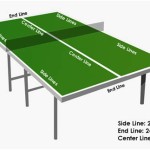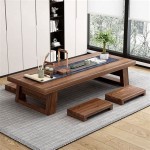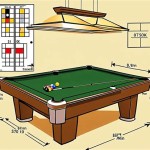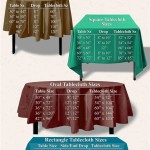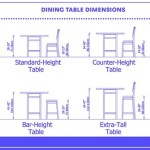How Much Is a Solid Wood Dining Table?
The cost of a solid wood dining table represents a significant investment for many homeowners. Unlike tables made from veneers or manufactured wood products, solid wood tables offer durability, timeless aesthetics, and the potential for increased value over time. However, the price range for solid wood dining tables is broad, influenced by a complex interplay of factors like wood species, size, design complexity, construction methods, and brand reputation. Understanding these factors is crucial for making an informed purchasing decision that aligns with both budget and aesthetic preferences.
The term "solid wood" itself can be somewhat ambiguous. Ideally, it implies that the entirety of the tabletop and supporting structure is constructed from solid pieces of lumber. However, some manufacturers may use the term to denote that only certain components, such as the tabletop surface, are made of solid wood, while other parts, like the legs or apron, might be constructed from engineered wood or a different, less expensive solid wood species. Therefore, it is essential to clarify the construction details with the retailer or manufacturer before making a purchase.
The general price range for solid wood dining tables can vary dramatically, starting from a few hundred dollars for smaller, mass-produced models to several thousand dollars or more for larger, custom-designed pieces crafted from premium hardwoods. This article will explore the primary factors that contribute to the varying costs associated with solid wood dining tables, providing a framework for understanding their pricing and making informed choices.
Wood Species: A Primary Cost Driver
The type of wood used in a dining table's construction is arguably the most significant factor influencing its price. Different wood species possess varying characteristics that affect their availability, workability, and aesthetic appeal, all of which contribute to their market value. Hardwoods, generally known for their density and durability, tend to be more expensive than softwoods.
Common hardwoods used in dining table construction include oak, maple, cherry, walnut, and ash. Oak is a popular choice due to its strength, durability, and distinctive grain pattern. White oak is often preferred over red oak due to its greater resistance to water damage, making it suitable for tabletops that may experience spills. Maple is another durable option, known for its smooth, fine grain and light color, which makes it easily adaptable to various stains and finishes. Cherry is prized for its rich, reddish-brown hue that deepens and develops character over time. Walnut is a premium hardwood, renowned for its dark, luxurious color and intricate grain patterns, typically commanding a higher price point. Ash offers a similar strength to oak but with a lighter color and more open grain, often used as a more affordable alternative.
Exotic hardwoods, such as teak, mahogany, and bubinga, are considerably more expensive than domestic hardwoods due to their limited availability and unique aesthetic qualities. Teak, known for its exceptional resistance to moisture and decay, is often used in outdoor furniture but can also be incorporated into high-end dining tables. Mahogany is valued for its rich color, fine grain, and stability, making it a popular choice for fine furniture. Bubinga, originating from Africa, boasts a striking reddish-brown color and dramatic grain patterns, adding a touch of luxury and exclusivity to dining tables.
The pricing difference between these wood species can be substantial. For example, a dining table made from solid walnut may cost significantly more than a similar table constructed from solid oak or maple. The rarity, demand, and difficulty in working with certain hardwoods all contribute to their higher price.
Size, Design, and Construction Methods
Beyond the wood species, the size, design complexity, and construction methods employed in creating a solid wood dining table also play a crucial role in determining its cost. Larger tables, naturally, require more material and labor, thus increasing the price. Similarly, intricate designs with elaborate carvings, inlays, or custom features will be more expensive than simple, minimalist designs.
The size consideration extends beyond just the tabletop surface. The thickness of the tabletop, the dimensions of the legs, and the presence of features like extension leaves all contribute to the overall material cost. A thicker tabletop will generally be more expensive due to the increased wood required and the more complex milling and finishing processes involved.
Construction methods significantly impact the table's durability and overall cost. Traditional joinery techniques, such as mortise and tenon joints, dovetail joints, and tongue and groove joints, are known for their strength and longevity. However, these methods require skilled craftsmanship and more time, which translates into a higher price. Tables that are mass-produced using less labor-intensive construction methods, such as screws or metal fasteners, may be less expensive but potentially less durable over the long term.
The design of the table legs also influences the cost. Simple, straight legs are generally less expensive than more elaborate turned or carved legs. Custom leg designs, especially those requiring specialized tooling or techniques, can significantly increase the overall price of the table.
Furthermore, the inclusion of extension leaves adds complexity to the design and construction, requiring precise mechanisms to ensure smooth and seamless extension. Tables with self-storing leaves or geared extension systems are often more expensive than those with simpler extension mechanisms.
Finishing, Brand Reputation, and Customization
The finishing process applied to a solid wood dining table significantly impacts its appearance, durability, and overall cost. High-quality finishes not only enhance the wood's natural beauty but also provide protection against scratches, stains, and moisture damage. The type of finish used, the number of coats applied, and the skill of the finisher all contribute to the final price.
Common finishes for solid wood dining tables include lacquer, varnish, polyurethane, and oil-based finishes. Lacquer provides a durable and glossy finish, while varnish offers a more traditional look with good scratch resistance. Polyurethane is a synthetic finish known for its exceptional durability and resistance to water damage. Oil-based finishes, such as tung oil or linseed oil, penetrate the wood, highlighting its natural grain and providing a warm, matte finish. The choice of finish depends on the desired aesthetic, the level of protection required, and the budget.
The brand reputation of the manufacturer also plays a role in pricing. Established brands with a reputation for quality craftsmanship and attention to detail often command higher prices than lesser-known brands. These brands typically invest in high-quality materials, skilled labor, and rigorous quality control processes, resulting in superior products that justify the higher price point. Additionally, a strong brand reputation often provides assurance of customer satisfaction and long-term value.
Customization options can significantly impact the final price of a solid wood dining table. Custom sizes, shapes, finishes, and design features allow homeowners to create a unique piece that perfectly suits their needs and preferences. However, custom designs require more time, effort, and specialized skills, leading to a higher price compared to standard, mass-produced tables. Customization may involve selecting specific wood species, modifying the table's dimensions, incorporating unique design elements, or creating a custom finish to match existing furniture.
In conclusion, the cost of a solid wood dining table is a complex calculation influenced by numerous factors. Wood species, size, design complexity, construction methods, finishing techniques, brand reputation, and customization options all contribute to the final price. By carefully considering these factors, consumers can make informed purchasing decisions that align with their budget and aesthetic preferences, ensuring they invest in a solid wood dining table that will provide years of enjoyment and lasting value.

Terra Natural Oak Dining Table 65 90

Reclaimed Wood Rustic Solid Farmhouse Dining Table The Andersson

Nathan James Briggs Modern Light Brown Mdf With Wood Veneer 70 In Sled Base Dining Table 6 Seater Kitchen Solid Legs 41601

Oak Solid Wood Round Dining Table

100 Inch Gathering Dining Table

Natural Wood Contemporary Dining Table

Primo International Sutherland 70 Rustic Dining Table

Greenwich Solid Acacia Wood 5 Piece Dining Set The Dump Furniture

Chvans 72 Large Solid Wood Dinner Table For 4 8 Person Modern Farmhouse Kitchen With Adjustable Heavy Duty Metal Leg Rectangular Dining

Keira Round Dining Table 48 Cool Walnut West Elm
Related Posts

